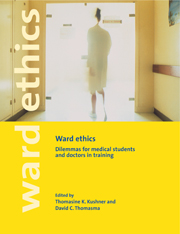Book contents
- Frontmatter
- Contents
- Acknowledgments
- List of contributors
- Prologue. Breaking the silence
- Letter from a young doctor
- Part I On caring for patients
- Section 1 Performing procedures
- 1 The responsibility of informing
- 2 Treating despite discomfort and self-doubt
- 3 Blaming the patient
- 4 Breaking the code: is a promise always a promise?
- 5 The newly dead
- 6 Asking for help: who's listening?
- Section 2 Problems in truth-telling
- Section 3 Setting boundaries
- Part II On becoming a “team player”: searching for esprit de corps and conflicts of socialization
- Section 5 Argot, jargon, and questionable humor: assuming the mantle at the patient's expense
- Section 6 Making waves: questioning authority and the status quo
- Section 7 Perceiving misconduct and whistle-blowing: observing peers or superiors commit an act deemed unethical
- Epilogue: Using this book
- Glossary
- Index
5 - The newly dead
Published online by Cambridge University Press: 05 February 2015
- Frontmatter
- Contents
- Acknowledgments
- List of contributors
- Prologue. Breaking the silence
- Letter from a young doctor
- Part I On caring for patients
- Section 1 Performing procedures
- 1 The responsibility of informing
- 2 Treating despite discomfort and self-doubt
- 3 Blaming the patient
- 4 Breaking the code: is a promise always a promise?
- 5 The newly dead
- 6 Asking for help: who's listening?
- Section 2 Problems in truth-telling
- Section 3 Setting boundaries
- Part II On becoming a “team player”: searching for esprit de corps and conflicts of socialization
- Section 5 Argot, jargon, and questionable humor: assuming the mantle at the patient's expense
- Section 6 Making waves: questioning authority and the status quo
- Section 7 Perceiving misconduct and whistle-blowing: observing peers or superiors commit an act deemed unethical
- Epilogue: Using this book
- Glossary
- Index
Summary
CASE
“Patient or cadaver?”
One evening during my first year of medical school I was observing a preceptor in the Emergency Department. A paramedic-staffed ambulance brought in a man who had been in cardiac arrest for some time. In the Emergency Department it was clear from the start that the situation looked very grim. The doctor asked if I was CPR certified and if I wanted to do cardiopulmonary resuscitation on this patient. I told him that I was certified, but I wasn't ready to take on this situation. He brushed aside my reluctance and said, “Don't worry about it. Go ahead and try. I'll be here next to you.” I administered effective CPR. Yet nothing worked, and eventually the patient was declared dead.
At that point, the curtain was pulled around the bed and the doctor told me he was going to practice intubation using the corpse that, only moments ago, had been his patient. He explained that since all the paramedics were now trained to intubate patients in the field, he seldom had the opportunity to practice this important skill. Since he didn't want to lose his proficiency, he felt this was a good way to maintain it. Later, I heard that there was also a group of training paramedic students who needed intubation experience and were invited to make use of this “practice opportunity.”
- Type
- Chapter
- Information
- Ward EthicsDilemmas for Medical Students and Doctors in Training, pp. 56 - 65Publisher: Cambridge University PressPrint publication year: 2001
- 1
- Cited by



